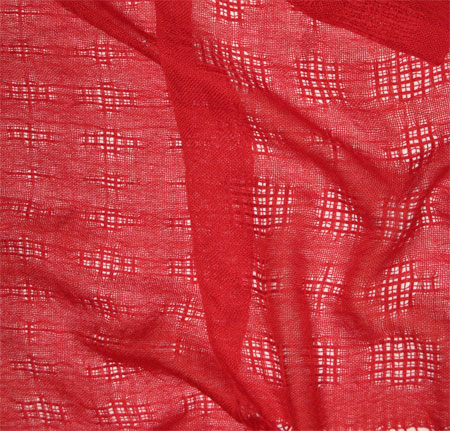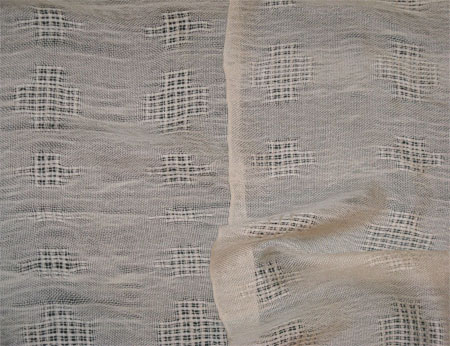This is not the way I wanted to start a new year – by having 10 days between blog posts. Writing a blog post has been on my list of things to do for over a week, and somehow, other things kept taking precedence. There’s nothing I can do about that now; I can only try to do better as we move forward.
In my last post I showed you some cashmere silk eggshell lace scarves on my counterbalance loom, and promised more info about them. Here it is, finally.
At one of my December shows a customer ordered two custom cashmere silk lace scarves. I’m always happy to comply with these requests, although I had to tell this woman that she couldn’t have exactly what she wanted. She wanted a scarf just like the one I was wearing. Should have been simple, shouldn’t it? But it wasn’t.
I was wearing one of the eggshell lace scarves I’d made on my Macomber when I was trying a new pattern. Those scarves were not stable enough, and can’t be sold. I often wear one at a show because they go with everything, and when I’m wearing the scarf the problems are not obvious. So I explained why I would have to modify the pattern in her scarf. She understood, but was clear that she wanted me to get as close as possible. I assured her I’d try.
I knew that I couldn’t really know what would work by using another fiber; I had to do my testing with cashmere silk yarn. I also knew I had a limited quantity of the eggshell, a popular color, and I didn’t really want to use any of it up in samples/tests that may or may not be successful. So I decided to use my least-requested color, a bright Christmas red.
I also decided that I would only use a lace pattern I could weave on my counterbalance loom. The cashmere silk scarves I’ve woven on the counterbalance loom have been almost completely successful; the ones I’ve woven on my Mac not so much. I think it’s a combination of the loom and the weave structures I’ve chosen, but I almost always make the tension too tight and distort the scarves.
So I spent some time with my Fiberworks software, and using block design strategies, created a Swedish lace draft. I measured out enough warp for two red scarves, and threaded up the loom. I set off weaving, and was pleased with the results. Although it’s clear that while a piece is still on the loom you can’t tell for certain what it will look like after wet finishing, with practice you can get a good idea.
As I was weaving the first scarf, I decided that I could get even closer to my customer’s wishes. So I cut off that scarf, wet finished it to be sure I was right, and re-threaded the loom. I was also happy with the second scarf. Here are both of them.

After wet finishing the second scarf, I decided I could make even more changes to get even closer to my customer’s wishes. I also figured that I ought to warp for four scarves instead of my usual three, since I have had lots of customer interest in eggshell scarves. So I was off and running.
Unfortunately, things didn’t go quite as smoothly with the eggshell scarves. It had nothing to do with the modifications to the draft. For reasons that I never could quite identify, I had all sorts of problems with the threads near the selvedges. They broke often, they fuzzed up, the refused to produce straight selvedges. I tried all the tricks I knew — weighting the selvedge threads, doubling those threads, using a temple — nothing made any difference. Ultimately, I did get four saleable scarves woven, but I’m embarrassed by the selvedges on all of them to one degree or another. I’m not showing you a closeup of them with good reason. But here are two of the scarves. (You can tell at a glance I haven’t pressed them yet.)

Actually, I did have one idea about the selvedge problem with the eggshell scarves. The reed I use on my counterbalance loom is the one that came with it when I bought the loom, after it had sat in a damp garage for more than a year. The reed was very rusty, and I was poor, so I cleaned it with naval jelly, a stiff brush, and lots of elbow grease. Although it didn’t hassle the red yarn, I guessed that the eggshell yarn was just a bit more delicate, and that there were possibly tiny burs on the red that frayed the yarn. So I bit the bullet and ordered a brand new stainless steel reed. I figured that my little loom got enough use that it (and I) deserved a new tool. The reed was out of stock, so I’ll have to wait a few weeks for it to arrive.
Of course, I’m weaving in the interim (tempus fugit, ya know), but I had to work on another order before I went back to the cashmere & silk. The eggshell was pretty frustrating, and the other special order is for black. The only other black cashmere silk scarves I made had a similar selvedge problem, and I didn’t think my brain could handle it. I’m hoping (probably without much chance of success) that the reed will come in quickly and I can use it for the black scarves.
I promise, I’ll try to post more frequently. I want to show you what I have on that little rigid heddle loom (and I want to get back to that!), the order that’s on my counterbalance now, and my plans for the towel exchange I joined this year.
Your turn: what have you been doing since the year changed its number?


[…] noted in a recent post that I wouldn’t weave cashmere silk on the Mac anymore. I said I tend to make the tension too […]
[…] Issues #1 When I was weaving those eggshell cashmere silk lace scarves, I noted a problem that I thought might have been caused by an old reed, and decided to order a new […]